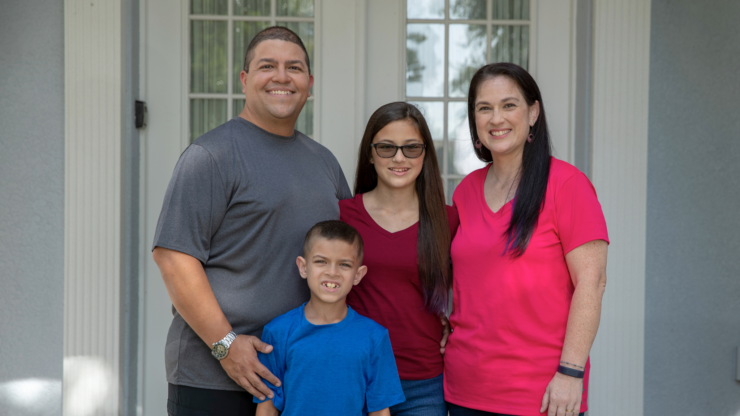Meet Chris Aguilar, an extraordinary father who looks just like any other parent, juggling the busy schedules of his two children. From flag football tournaments and college visits to band practice and chess club, Chris is always on the move. However, his family’s story is anything but ordinary.
Epilepsy, sometimes called a seizure disorder, is a condition that affects the brain. It’s diagnosed when a person experiences two or more seizures.
A seizure is a temporary change in normal brain activity, and is the main sign of epilepsy. Some seizures may look like moments of staring into space. Others can cause a person to fall, shake, and lose awareness of what’s happening around them.
Epilepsy is not just a single condition; it encompasses various types of seizures and affects millions of people worldwide. In fact, it is the fourth most common neurological disorder, surpassed only by migraine, stroke, and Alzheimer’s disease. Approximately 3.4 million Americans and 50 million individuals globally live with epilepsy, highlighting the widespread impact of this condition.
Neither Chris nor his wife Shannon have epilepsy, which made it all the more shocking when their daughter Bella started experiencing seizures at a mere 18 months old. To their dismay, Bella’s seizures were uncontrollable and resistant to medication. Despite trying various combinations of drugs, the seizures persisted and only brought forth more side effects.
Parentology caught up with Aguilar to discuss his family, epilepsy, and the innovative therapy treatment that changed their lives.
Double the Trouble
For many individuals with epilepsy, medications are the first line of defense. However, about one-third of all people with epilepsy experience drug-resistant epilepsy (DRE). This means that despite trying multiple anti-seizure medications, their seizures persist. Unfortunately, if two medications fail to control seizures, the likelihood of achieving seizure freedom with a third medication becomes significantly diminished. Despite this reality, most patients are often prescribed additional medications instead of exploring non-drug therapy options.
“There wasn’t a lot of information when we first started on this journey,” says Aguilar.
Undertreated epilepsy poses several risks, including increased hospital and emergency visits, potential developmental issues, changes in cognitive function and memory, difficulties with social interactions, and an elevated risk of seizure-related injuries. It’s crucial to address epilepsy comprehensively to mitigate these adverse outcomes.
While having one child with epilepsy can increase the risk of a sibling developing the disease (by about 9.5% in the Aguilar’s case), the likelihood of having two children with epilepsy remains relatively low. Yet, this became Chris’ reality when his son, Ethan, was diagnosed with epilepsy at the age of five, just seven years after Bella’s diagnosis.
“Our whole world revolved around Bella, from doctors’ visits, testing, hospital stays. We went to Miami, we went to Boston, we went to the Mayo Clinic,” says Aguilar. “We were so focused on Bella and everything that was going with her that we completely missed the signs for Ethan.”
Eventually, one of Ethan’s teachers called the Aguilars.
“It wasn’t until he was in kindergarten that one of the teachers said, hey, I’m noticing some things with Ethan, and I think they may be epilepsy-related,” Aguilar recalls. After a visit with their pediatric neurologist and an EEG, the test results confirmed that Ethan did have epilepsy.
ALSO: Could Regenerative Therapy Transform Lives of Children with Autism?
Similar to his sister, Ethan’s seizures were difficult to manage, leading to numerous hospital visits for the Aguilar family. “Both of my kids went through a number of medications,” says Aguilar. “There were some medications that worked fantastic for my daughter, but had the complete opposite effect on my son, and vice versa. We couldn’t even trust that both of them could have the same medication at the same time.”
Over a span of more than ten years, the Aguilars witnessed their children falling behind in school, struggling with memory loss, and becoming socially withdrawn due to their uncontrollable seizures. “When she was on medication, Bella was very shy. She rarely talked about epilepsy,” says Aguilar. “We became almost helicopter parents. She was rarely able to go to friends’ homes and things like that because not everybody understands what’s involved with epilepsy… she missed out on a lot”
It wasn’t until they were introduced to VNS Therapy™, a unique supplementary treatment for individuals with drug-resistant epilepsy, that Chris finally witnessed a transformation.
The Turning Point: VNS Therapy
While initially skeptical, the Aguilars realized that this treatment might just be the answer.
“When we realized that both kids had drug-resistant epilepsy, we really started taking a deeper look into VNS Therapy,” says Aguilar. “Once my son was diagnosed a few years later, we were confident that the benefits would also apply to our son.”
By providing an innovative add-on treatment option for people aged four and above with drug-resistant epilepsy and focal (partial-onset) seizures, VNS Therapy offers hope and improved seizure control. Unlike traditional medications, this therapeutic implant operates through a small device implanted in the chest, which is connected to the left vagus nerve in the neck via a thin wire lead. The implantation procedure, usually performed under general anesthesia, takes about one to two hours and involves two small incisions. Importantly, it does not require invasive brain surgery.
The impact of VNS Therapy can be life-changing for many people who are struggling with drug-resistant epilepsy. People using the treatment often experience a reduction in the frequency and severity of their seizures. Seizures become shorter in duration, allowing for better recovery time. Numerous quality-of-life benefits have also been observed, including improvements in alertness, mood, memory, and the postictal period (the recovery phase after a seizure). Over time, the benefits tend to improve further, providing patients with a path towards a better life.
The treatment has already made a difference in the lives of more than 125,000 people worldwide, including over 35,000 children. In fact, a survey conducted among patients and caregivers revealed that an overwhelming majority wished they had known about the treatment sooner, and many expressed a reduced worry about seizures due to the positive impact.
With the device, Bella, now 16 years old, has gained better control over her seizures. She is currently preparing for college, taking advanced courses as she enters her senior year of high school. Bella has excelled in her academic pursuits, serving as the vice president of her junior class, leading fundraising initiatives at her school, and shining as a star athlete on her flag football team.
ALSO: Dr. Jenny Yip Talks Teen Anxiety and Mental Health
“It was like a spark. She was more vibrant. She was doing a lot better in school. Her grades picked up. She was more social, and she took VNS Therapy as an opportunity to talk to people about her journey with epilepsy,” says Aguilar. “She spoke at a public speaking contest, and the theme was, what’s inside of you? Most people spoke about ‘this or that makes me unique,’ etc. Bella said ‘This implant makes me who I am.’ And she made it to the finals.”
Previously unable to participate in sports, Bella’s transformation was instant.
“She joined every sports team in middle school that she could join. So she made her soccer team, her volleyball team, her basketball team, her track and field team. She was the only student in three years of middle school that made all four teams, boy or girl,” Aguilar says proudly. “She got a special plaque when she finished middle school. She gives 100% effort. Bella’s out there, hustling. They actually named an award after her, an award for heart and hustle.”
Ethan, who began receiving VNS Therapy three years after his sister, has experienced a remarkable transformation.
“Ethan also has drug-resistant epilepsy, so that journey was a lot quicker because we knew VNS Therapy worked for Bella,” says Aguilar. Unfortunately, due to the pandemic, the family had to wait an additional six months for the treatment.
Now 12 years old, he has emerged from his shell, blossoming into a social butterfly with a remarkable sense of humor. Growing in confidence and independence, Ethan has thrived. Last summer, Chris and Shannon even had the opportunity to embark on their first couples-only trip to Jamaica, a luxury they hadn’t experienced since Bella’s birth. “We’ve gone on date nights, which we never used to be able to do. We took our first trip out of the country by ourselves, and we had the confidence to leave Ethan and Bella in the care of family members, because of the therapy and the resources we were given.”
Advice for Parents with Epileptic Children
Aguilar advises that parents who have children with epilepsy should do their homework, including talking to families who have undergone VNS Therapy, medications or other treatment options. He tells us that there are many more resources out there than when his family started on this journey. “No two families will always have the same results. VNS Therapy was something we chose as a family that has worked for us,” says Aguilar. “If I had to do it all over again, even with the heartache, the sleepless nights, I would still go through it again because of what my children have become.”
Chris Aguilar’s journey as a father has been far from ordinary. With the support of VNS Therapy, he has witnessed his children flourish, overcoming the challenges of epilepsy and seizing control of their lives. “I learned that their journey, everything they’ve gone through, made them that much stronger in the world,” Aguilar says. “I can be their support system through that journey and build them up as individuals and as people, that is my reward.“
If you or someone you know is living with uncontrolled seizures, seeking treatment at a specialized epilepsy facility and discussing VNS Therapy™ with a neurologist could be a crucial step towards regaining control. For more information and resources about VNS Therapy, you can visit VNSTherapy.com and SeizureControl.com.








Add comment